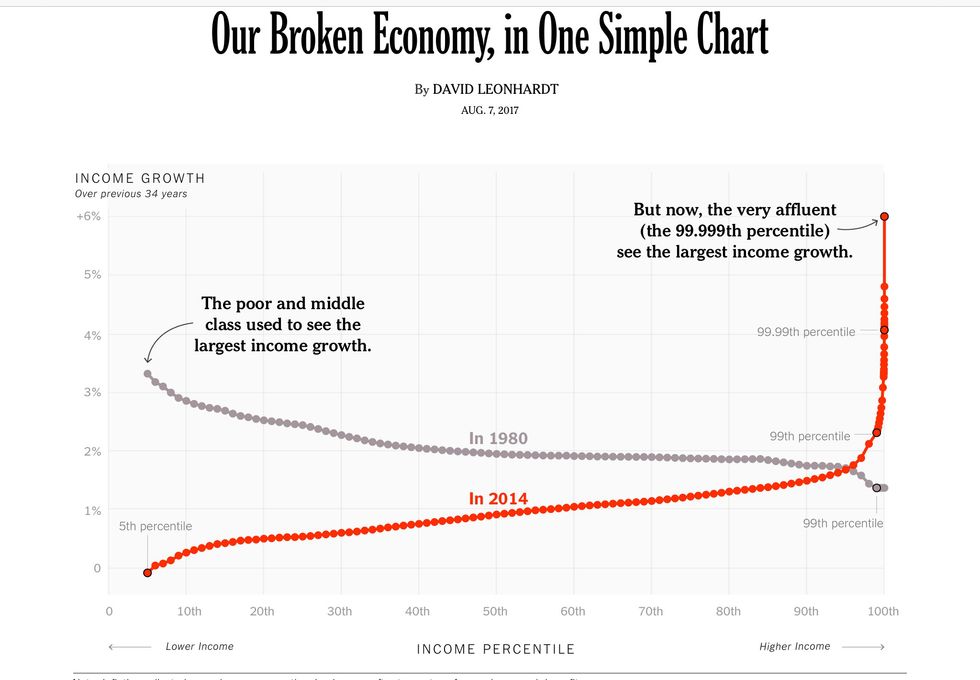
Many Americans can't remember anything other than an economy with skyrocketing inequality, in which living standards for most Americans are stagnating and the rich are pulling away. It feels inevitable.
But it's not.
A well-known team of inequality researchers — Thomas Piketty, Emmanuel Saez and Gabriel Zucman — has been getting some attention recently for a chart it produced. It shows the change in income between 1980 and 2014 for every point on the distribution, and it neatly summarizes the recent soaring of inequality.
The line on the chart (which we have recreated as the red line above) resembles a classic hockey-stick graph. It's mostly flat and close to zero, before spiking upward at the end. That spike shows that the very affluent, and only the very affluent, have received significant raises in recent decades.
This line captures the rise in inequality better than any other chart or simple summary that I've seen. So I went to the economists with a request: Could they produce versions of their chart for years before 1980, to capture the income trends following World War II. [chart not reproduced here for technical reasons but the analysis which follows explains what the chart showed].
The message is straightforward. Only a few decades ago, the middle class and the poor weren't just receiving healthy raises. Their take-home pay was rising even more rapidly, in percentage terms, than the pay of the rich.
The post-inflation, after-tax raises that were typical for the middle class during the pre-1980 period — about 2 percent a year — translate into rapid gains in living standards. At that rate, a household's income almost doubles every 34 years. (The economists used 34-year windows to stay consistent with their original chart, which covered 1980 through 2014.)
In recent decades, by contrast, only very affluent families — those in roughly the top 1/40th of the income distribution — have received such large raises. Yes, the upper-middle class has done better than the middle class or the poor, but the huge gaps are between the super-rich and everyone else.
The basic problem is that most families used to receive something approaching their fair share of economic growth, and they don't anymore.

It's true that the country can't magically return to the 1950s and 1960s (nor would we want to, all things considered). Economic growth was faster in those decades than we can reasonably expect today. Yet there is nothing natural about the distribution of today's growth — the fact that our economic bounty flows overwhelmingly to a small share of the population.
Different policies could produce a different outcome. My list would start with a tax code that does less to favor the affluent, a better-functioning education system, more bargaining power for workers and less tolerance for corporate consolidation.
Remarkably, President Trump and the Republican leaders in Congress are trying to go in the other direction. They spent months trying to take away health insurance from millions of middle-class and poor families. Their initial tax-reform planswould reduce taxes for the rich much more than for everyone else. And they want to cut spending on schools, even though education is the single best way to improve middle-class living standards over the long term.
Most Americans would look at these charts and conclude that inequality is out of control. The president, on the other hand, seems to think that inequality isn't big enough.
This column appeared in The New York Times on August 8, 2017
###
August 9, 2017
_Addendum.Today is New York Times Day on Voices4America. I will post a series of columns by Times columnist that I found illuminating for the situation America is in now. This is the first. Happy reading.
One more thing- -In her statement on Black Women's Equal Pay Day (in which she suggested strategies which would fix income inequality for black women), Senator Kamala Harris (Dem-CA) suggested strategies which might help the general population too. Check them out

